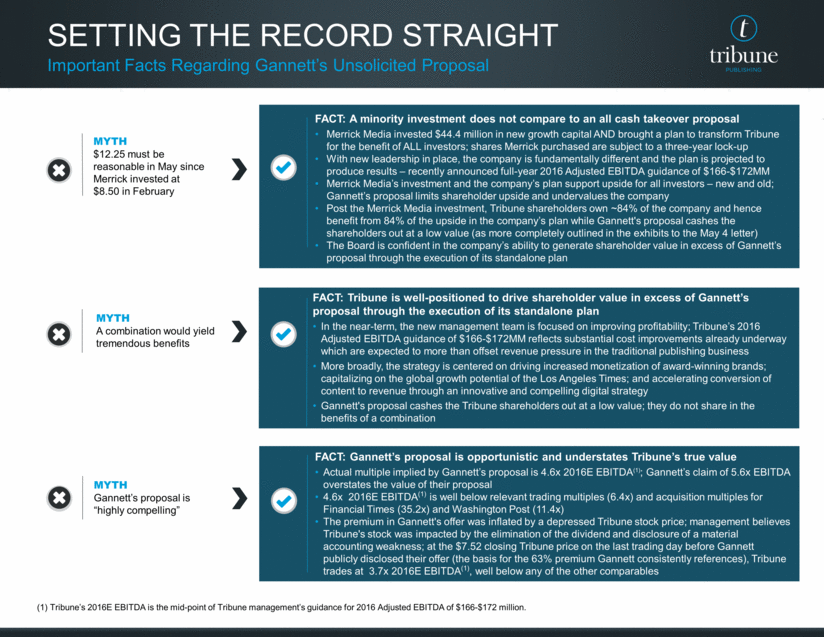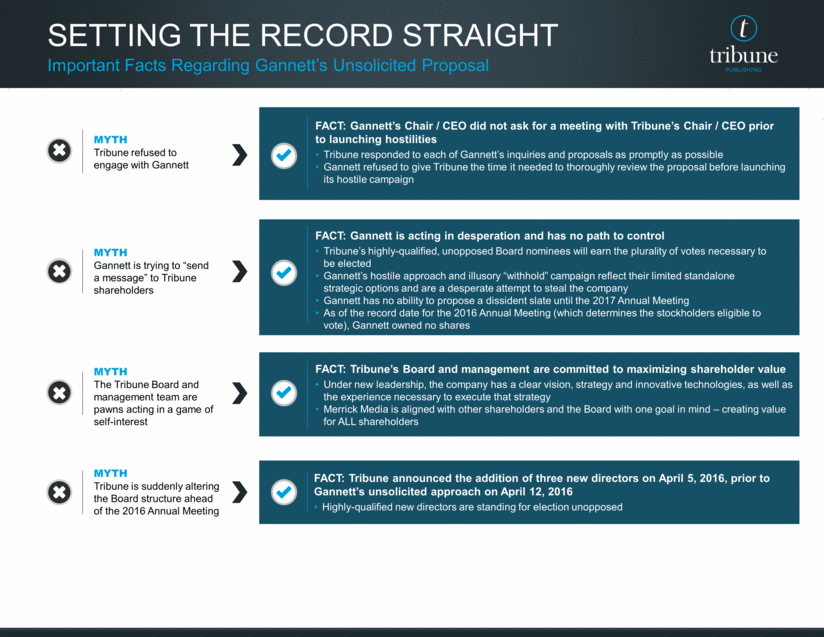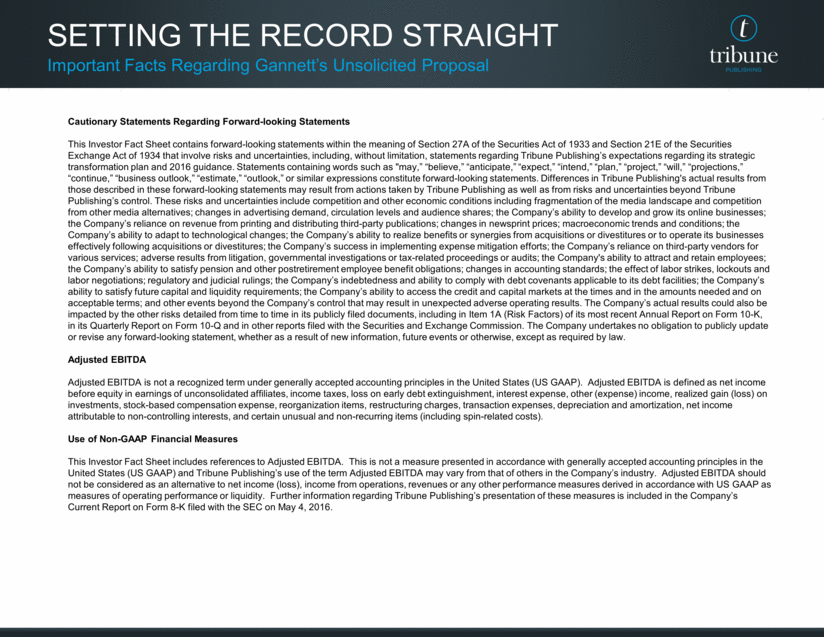Attached files
| file | filename |
|---|---|
| 8-K - 8-K - Tribune Publishing Co | a16-10756_18k.htm |
Exhibit 99.1
Setting the record straight Important Facts Regarding Gannett’s Unsolicited Proposal FACT: Tribune is well-positioned to drive shareholder value in excess of Gannett’s proposal through the execution of its standalone plan In the near-term, the new management team is focused on improving profitability; Tribune’s 2016 Adjusted EBITDA guidance of $166-$172MM reflects substantial cost improvements already underway which are expected to more than offset revenue pressure in the traditional publishing business More broadly, the strategy is centered on driving increased monetization of award-winning brands; capitalizing on the global growth potential of the Los Angeles Times; and accelerating conversion of content to revenue through an innovative and compelling digital strategy Gannett's proposal cashes the Tribune shareholders out at a low value; they do not share in the benefits of a combination MYTH A combination would yield tremendous benefits MYTH $12.25 must be reasonable in May since Merrick invested at $8.50 in February FACT: A minority investment does not compare to an all cash takeover proposal Merrick Media invested $44.4 million in new growth capital AND brought a plan to transform Tribune for the benefit of ALL investors; shares Merrick purchased are subject to a three-year lock-up With new leadership in place, the company is fundamentally different and the plan is projected to produce results – recently announced full-year 2016 Adjusted EBITDA guidance of $166-$172MM Merrick Media’s investment and the company’s plan support upside for all investors – new and old; Gannett’s proposal limits shareholder upside and undervalues the company Post the Merrick Media investment, Tribune shareholders own ~84% of the company and hence benefit from 84% of the upside in the company’s plan while Gannett's proposal cashes the shareholders out at a low value (as more completely outlined in the exhibits to the May 4 letter) The Board is confident in the company’s ability to generate shareholder value in excess of Gannett’s proposal through the execution of its standalone plan FACT: Gannett’s proposal is opportunistic and understates Tribune’s true value Actual multiple implied by Gannett’s proposal is 4.6x 2016E EBITDA(1); Gannett’s claim of 5.6x EBITDA overstates the value of their proposal 4.6x 2016E EBITDA(1) is well below relevant trading multiples (6.4x) and acquisition multiples for Financial Times (35.2x) and Washington Post (11.4x) The premium in Gannett's offer was inflated by a depressed Tribune stock price; management believes Tribune's stock was impacted by the elimination of the dividend and disclosure of a material accounting weakness; at the $7.52 closing Tribune price on the last trading day before Gannett publicly disclosed their offer (the basis for the 63% premium Gannett consistently references), Tribune trades at 3.7x 2016E EBITDA(1), well below any of the other comparables MYTH Gannett’s proposal is “highly compelling” (1) Tribune’s 2016E EBITDA is the mid-point of Tribune management’s guidance for 2016 Adjusted EBITDA of $166-$172 million.

Setting the record straight Important Facts Regarding Gannett’s Unsolicited Proposal FACT: Gannett is acting in desperation and has no path to control Tribune’s highly-qualified, unopposed Board nominees will earn the plurality of votes necessary to be elected Gannett’s hostile approach and illusory “withhold” campaign reflect their limited standalone strategic options and are a desperate attempt to steal the company Gannett has no ability to propose a dissident slate until the 2017 Annual Meeting As of the record date for the 2016 Annual Meeting (which determines the stockholders eligible to vote), Gannett owned no shares MYTH Gannett is trying to “send a message” to Tribune shareholders FACT: Tribune’s Board and management are committed to maximizing shareholder value Under new leadership, the company has a clear vision, strategy and innovative technologies, as well as the experience necessary to execute that strategy Merrick Media is aligned with other shareholders and the Board with one goal in mind – creating value for ALL shareholders MYTH The Tribune Board and management team are pawns acting in a game of self-interest FACT: Tribune announced the addition of three new directors on April 5, 2016, prior to Gannett’s unsolicited approach on April 12, 2016 Highly-qualified new directors are standing for election unopposed MYTH Tribune is suddenly altering the Board structure ahead of the 2016 Annual Meeting MYTH Tribune refused to engage with Gannett FACT: Gannett’s Chair / CEO did not ask for a meeting with Tribune’s Chair / CEO prior to launching hostilities Tribune responded to each of Gannett’s inquiries and proposals as promptly as possible Gannett refused to give Tribune the time it needed to thoroughly review the proposal before launching its hostile campaign

Setting the record straight Important Facts Regarding Gannett’s Unsolicited Proposal Cautionary Statements Regarding Forward-looking Statements This Investor Fact Sheet contains forward-looking statements within the meaning of Section 27A of the Securities Act of 1933 and Section 21E of the Securities Exchange Act of 1934 that involve risks and uncertainties, including, without limitation, statements regarding Tribune Publishing’s expectations regarding its strategic transformation plan and 2016 guidance. Statements containing words such as "may,” “believe,” “anticipate,” “expect,” “intend,” “plan,” “project,” “will,” “projections,” “continue,” “business outlook,” “estimate,” “outlook,” or similar expressions constitute forward-looking statements. Differences in Tribune Publishing's actual results from those described in these forward-looking statements may result from actions taken by Tribune Publishing as well as from risks and uncertainties beyond Tribune Publishing’s control. These risks and uncertainties include competition and other economic conditions including fragmentation of the media landscape and competition from other media alternatives; changes in advertising demand, circulation levels and audience shares; the Company’s ability to develop and grow its online businesses; the Company’s reliance on revenue from printing and distributing third-party publications; changes in newsprint prices; macroeconomic trends and conditions; the Company’s ability to adapt to technological changes; the Company’s ability to realize benefits or synergies from acquisitions or divestitures or to operate its businesses effectively following acquisitions or divestitures; the Company’s success in implementing expense mitigation efforts; the Company’s reliance on third-party vendors for various services; adverse results from litigation, governmental investigations or tax-related proceedings or audits; the Company's ability to attract and retain employees; the Company’s ability to satisfy pension and other postretirement employee benefit obligations; changes in accounting standards; the effect of labor strikes, lockouts and labor negotiations; regulatory and judicial rulings; the Company’s indebtedness and ability to comply with debt covenants applicable to its debt facilities; the Company’s ability to satisfy future capital and liquidity requirements; the Company’s ability to access the credit and capital markets at the times and in the amounts needed and on acceptable terms; and other events beyond the Company’s control that may result in unexpected adverse operating results. The Company’s actual results could also be impacted by the other risks detailed from time to time in its publicly filed documents, including in Item 1A (Risk Factors) of its most recent Annual Report on Form 10-K, in its Quarterly Report on Form 10-Q and in other reports filed with the Securities and Exchange Commission. The Company undertakes no obligation to publicly update or revise any forward-looking statement, whether as a result of new information, future events or otherwise, except as required by law. Adjusted EBITDA Adjusted EBITDA is not a recognized term under generally accepted accounting principles in the United States (US GAAP). Adjusted EBITDA is defined as net income before equity in earnings of unconsolidated affiliates, income taxes, loss on early debt extinguishment, interest expense, other (expense) income, realized gain (loss) on investments, stock-based compensation expense, reorganization items, restructuring charges, transaction expenses, depreciation and amortization, net income attributable to non-controlling interests, and certain unusual and non-recurring items (including spin-related costs). Use of Non-GAAP Financial Measures This Investor Fact Sheet includes references to Adjusted EBITDA. This is not a measure presented in accordance with generally accepted accounting principles in the United States (US GAAP) and Tribune Publishing’s use of the term Adjusted EBITDA may vary from that of others in the Company’s industry. Adjusted EBITDA should not be considered as an alternative to net income (loss), income from operations, revenues or any other performance measures derived in accordance with US GAAP as measures of operating performance or liquidity. Further information regarding Tribune Publishing’s presentation of these measures is included in the Company’s Current Report on Form 8-K filed with the SEC on May 4, 2016.

